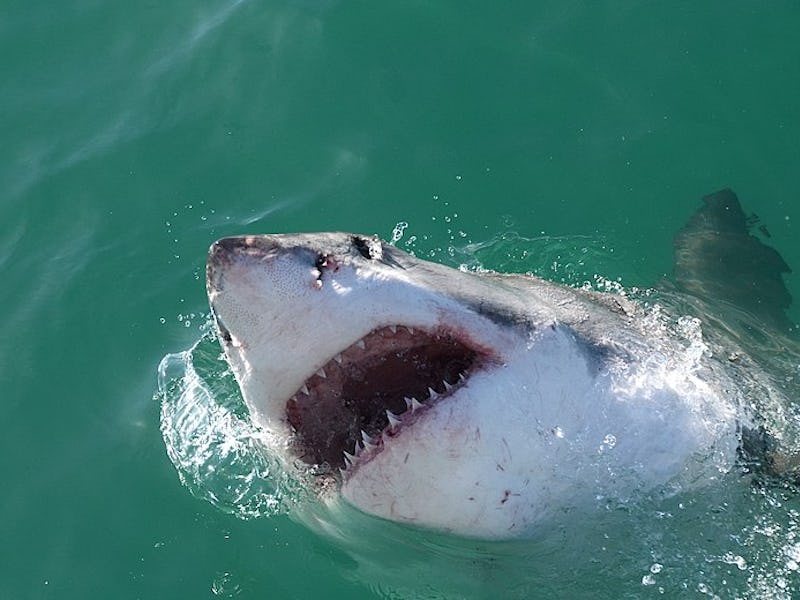Scientists Discover the One Thing That Great White Sharks Are Afraid Of
They are the ocean's top predator — almost.

Great white sharks don’t need much introduction. They have a firm hold on human imaginations and have been around for much longer: For 400 million years these intelligent behemoths have cruised through the ocean practically undeterred by a predatory rival. However, there’s increasing evidence that there is one ocean creature that can match them — and a new study shows these killers are causing great whites to flee.
In 2017, a series of great white shark deaths made the news: Five carcasses washed ashore on beaches near Cape Town, South Africa, each missing its liver. The bite marks on the great whites’ bellies connected the attacks to Orcinus orca, commonly known as the killer whale. A study released Tuesday in Nature demonstrates that while on the other side of the planet, orcas are still the top predator above sharks, Californian great whites seem to have also learned it’s best to get away as soon as possible.
While tensions between orcas and great whites are known, this study offers an unprecedented look at what happens below the surface, before an attack even happens.
This study is based off data collected on 165 white sharks who were tagged between 2006 and 2013, along with 27 years worth of surveys on the seals, orcas, and sharks that spend time around the Farallon Islands. These islands, just off of San Francisco, are where great white sharks gather to hunt for young elephant seals each fall between September and December. It’s also the site where, in 1997, biologists documented orcas killing and consuming a great white for the first time.
The shark tagging data, partnered with long-term wildlife monitoring surveys, conclusively revealed that when orcas show up to the Farallon Islands, the great whites get the heck out of there.
“When confronted by orcas, white sharks will immediately vacate their preferred hunting ground and will not return for up to a year, even though the orcas are only passing through,” lead author and Monterey Bay Aquarium senior research scientist Salvador Jorgensen, Ph.D., announced Tuesday.
On average, when orcas are within 2 miles of the islands, the great whites will vacate their hunting grounds and move elsewhere. This is, in turn, a boon for the elephant seals they chow down on: Typically, an average of 40 island-circling elephant seals are annually eaten by these sharks. However, when orcas are nearby — which they were in 2009, 2011, and 2013 — the number of seals killed by sharks dropped by 62 percent compared to previous years.
Orcas are cool with murder.
“We don’t typically think about how fear and risk aversion might play a role in shaping where large predators hunt and how that influences ocean ecosystems,” Jorgensen says. “It turns out these risk effects are very strong even for large predators like white sharks — strong enough to redirect their hunting activity to less preferred but safe areas.”
It’s currently unknown how frequently the orcas documented here target the great whites as prey — either way they win because their presence, while infrequent, cuts out competition for the calorie-rich elephant seals. The effects of great white shark displacement are currently being studied, but there’s reason to believe that while the seals may enjoy the change, less sharks may mean an off-kilter ecosystem.
Abstract:
Predatory behavior and top-down effects in marine ecosystems are well-described, however, intraguild interactions among co-occurring marine top predators remain less understood, but can have far reaching ecological implications. Killer whales and white sharks are prominent upper trophic level predators with highly-overlapping niches, yet their ecological interactions and subsequent effects have remained obscure. Using long-term electronic tagging and survey data we reveal rare and cryptic interactions between these predators at a shared foraging site, Southeast Farallon Island (SEFI). In multiple instances, brief visits from killer whales displaced white sharks from SEFI, disrupting shark feeding behavior for extended periods at this aggregation site. As a result, annual predations of pinnipeds by white sharks at SEFI were negatively correlated with close encounters with killer whales. Tagged white sharks relocated to other aggregation sites, creating detectable increases in white shark density at Ano Nuevo Island. This work highlights the importance of risk effects and intraguild relationships among top ocean predators and the value of long-term data sets revealing these consequential, albeit infrequent, ecological interactions.